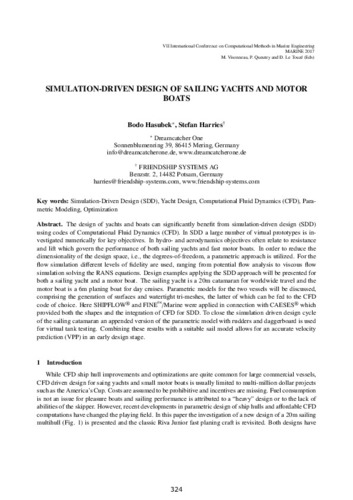Mostra el registre d'ítem simple
Simulation-driven design of sailing yachts and motor boats
| dc.contributor.author | Hasubek, Bodo |
| dc.contributor.author | Harries, Stefan |
| dc.date.accessioned | 2020-10-30T17:07:21Z |
| dc.date.available | 2020-10-30T17:07:21Z |
| dc.date.created | 2017 |
| dc.date.issued | 2017 |
| dc.identifier.citation | Hasubek, B.; Harries, S. Simulation-driven design of sailing yachts and motor boats. A: MARINE VII. "MARINE VII : proceedings of the VII International Conference on Computational Methods in Marine Engineering". CIMNE, 2017, p. 324-335. ISBN 978-84-946909-8-3. |
| dc.identifier.isbn | 978-84-946909-8-3 |
| dc.identifier.uri | http://hdl.handle.net/2117/331057 |
| dc.description.abstract | The design of yachts and boats can significantly benefit from simulation-driven design (SDD) using codes of Computational Fluid Dynamics (CFD). In SDD a large number of virtual prototypes is in- vestigated numerically for key objectives. In hydro- and aerodynamics objectives often relate to resistance and lift which govern the performance of both sailing yachts and fast motor boats. In order to reduce the dimensionality of the design space, i.e., the degrees-of-freedom, a parametric approach is utilized. For the flow simulation different levels of fidelity are used, ranging from potential flow analysis to viscous flow simulation solving the RANS equations. Design examples applying the SDD approach will be presented for both a sailing yacht and a motor boat. The sailing yacht is a 20m catamaran for worldwide travel and the motor boat is a 6m planing boat for day cruises. Parametric models for the two vessels will be discussed, comprising the generation of surfaces and watertight tri-meshes, the latter of which can be fed to the CFD code of choice. Here SHIPFLOW® and FINE™/Marine were applied in connection with CAESES® which provided both the shapes and the integration of CFD for SDD. To close the simulation driven design cycle of the sailing catamaran an appended version of the parametric model with rudders and daggerboard is used for virtual tank testing. Combining these results with a suitable sail model allows for an accurate velocity prediction (VPP) in an early design stage. |
| dc.format.extent | 12 p. |
| dc.language.iso | eng |
| dc.publisher | CIMNE |
| dc.rights | Open access |
| dc.subject | Àrees temàtiques de la UPC::Matemàtiques i estadística::Anàlisi numèrica::Mètodes en elements finits |
| dc.subject.lcsh | Finite element method |
| dc.subject.lcsh | Marine engineering |
| dc.subject.other | Simulation-Driven Design (SDD), Yacht Design, Computational Fluid Dynamics (CFD), Para- metric Modeling, Optimization |
| dc.title | Simulation-driven design of sailing yachts and motor boats |
| dc.type | Conference report |
| dc.subject.lemac | Enginyeria naval |
| dc.rights.access | Open Access |
| local.citation.contributor | MARINE VII |
| local.citation.publicationName | MARINE VII : proceedings of the VII International Conference on Computational Methods in Marine Engineering |
| local.citation.startingPage | 324 |
| local.citation.endingPage | 335 |


